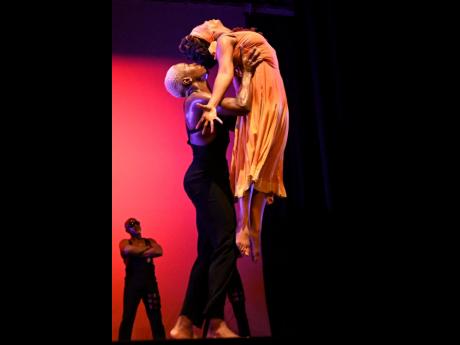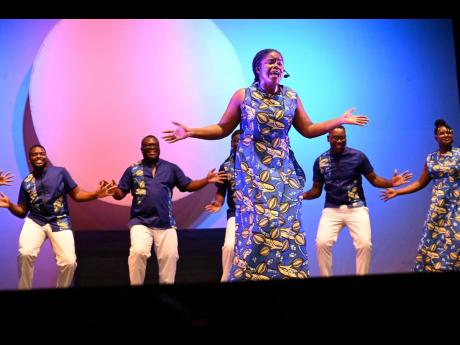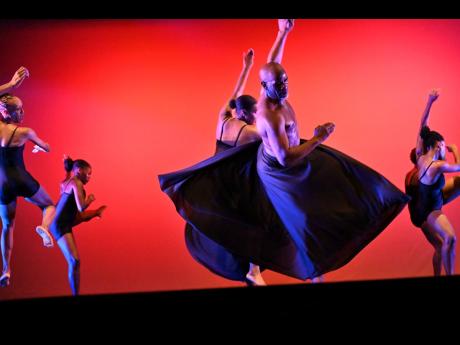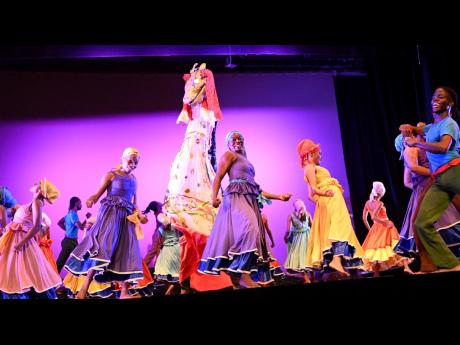NDTC dance season is a joy-filled package
The 2024 dance programme of the National Dance Theatre Company (NDTC) offers audiences mainly joyful items. Having opened at its accustomed venue, the Little Theatre, on July 19, the season closes on August 11. Fans have two weekends to enjoy selections from this year’s repertoire of 14 items: two musical, and the rest dance. On Sunday, when I saw the show, we got a nine-item programme.
It was a mix of old and new pieces, with the latter all in the first half of the roughly two-and-a-half-hour-long show. Still, it began with a 1997 work, Tintinabulum, choreographed by Rex Nettleford. Initially, it seems to be a straightforward depiction of life in a working-class Jamaican community, beginning with a birthing scene involving three mothers and their male babies. The boys grow and play together, with conflict occasionally rearing its unpleasant, but not unusual, head.
As men, they pursue diverse careers: one becomes a church leader, another an artistic leader, and the third a gang leader. The conflict foreshadowed earlier erupts again; three people die, and the women of the community grieve. The scene unexpectedly switches to heaven, indicated by three angels in all-white. A spiritual connection is made between the angels and the church community preparing to mourn, resulting in the entire community, including gang members, joining in the funeral.
“Unity can come from evil” is the clear message, but the dance’s power lies not in the simple story but in the strength of the production elements: Arlene Richards’ rich costumes, the London Philharmonic Orchestra’s glorious music, and the controlled energy of the company’s stage-filling dancers.
One of the dancers was Amaya Gomes, but she must have left early because moments after the dance ended, she was onstage for a solo, Luminosity (2023). Paul Newman, who choreographed the work, also designed the gorgeous floor-length floral skirt Gomes wore.
Desi Jones, our most popular trap set drummer who died earlier this year, had the next musical item dedicated to him. The bright, bouncy suite featured the music of Chalice, of which Jones was a founding member. The NDTC musicians performed the arrangement by Conrad Hall and Kevan Williams.
Creed (2024), an intriguing abstract work by NDTC Artistic Director Marlon Simms, was performed to Leonard Bernstein’s Adagio for Strings (from the String Quartet, Op 11). The dancers wore form-revealing black outfits designed by Simms and contorted themselves into the oddest shapes I have ever seen in a single dance.
The NDTC Singers, arranged by Dr Kathy Brown, performed South African freedom songs highlighting harmony and peace. Accompanied by drums, guitars, and keyboards, they sang celebratory pieces in African languages and English, ending with Freedom is Coming Tomorrow. The women’s ankle-length African print dresses added to the impact.
The show’s first half ended with Flight, a work choreographed in 2014 by guest choreographer Garfield Lemonius
While the company’s overall dancing was strong, the standout segment was a duet by lead dancers Mark Phinn and Kerry-Ann Henry. She appeared feather-light in his arms and moved with remarkable suppleness as they intertwined and extended their fingers, arms, feet, and bodies in a graceful, flowing creation. Although the second half had much to offer, this duet will likely be the sharpest memory.
After the intermission came three dances, Orville McFarlane’s Circa 2K(2003), Gene Carson’s Cry of the Spirit (1996) and Nettleford’s Gerrehbenta (1983). The printed programme’s description of the three movements of the first piece as “Video Lights”, “Posse” and “Bruk Out” give a clue to the content.
Keita-Marie Chamberlain Clarke was a picture of grace and beauty as she swirled around in her lilac dress for her solo, which was created by Carson and dedicated to the late dancer-choreographer. He was inspired by the popular gospel song Amazing Grace, which controversially suggests that human beings are “wretches”.
The 41-year-old gerreh-based dance that ended the evening was filled with vibrant energy and captured traditional folk rituals. It left both performers and the audience smiling as the curtain closed.




